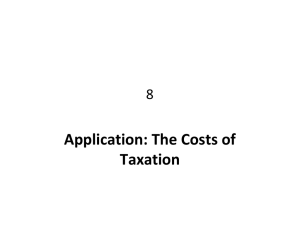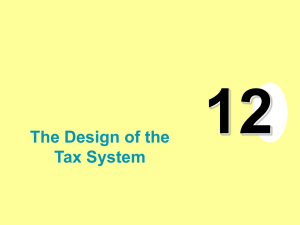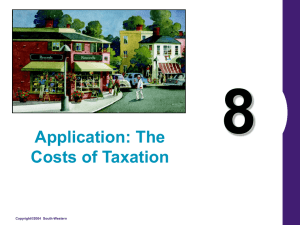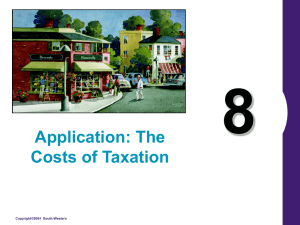Deadweight Loss Presentation
advertisement
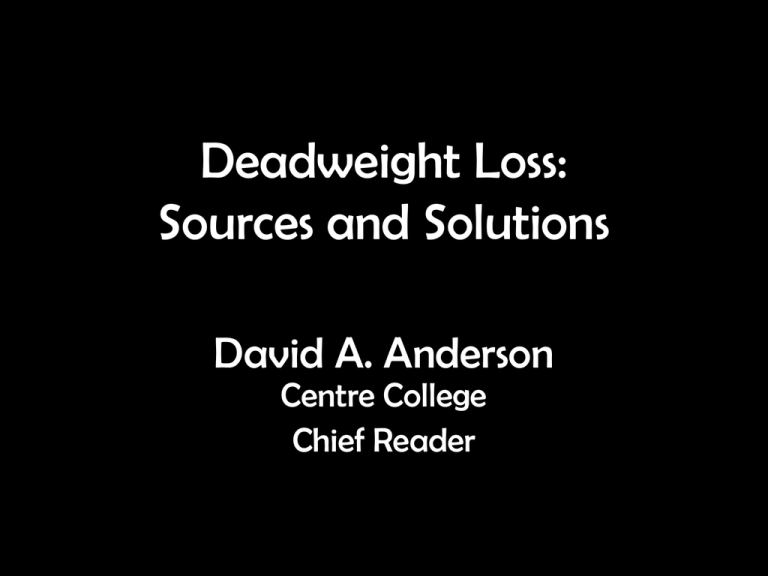
Deadweight Loss: Sources and Solutions David A. Anderson Centre College Chief Reader Deadweight Loss • What is it? • How do we teach it? • What do the AP questions on DWL look like? Defining Deadweight Loss “Losses associated with quantities of output that are greater than or less than the efficient level, as can result from market intervention such as taxes, or from externalities such as pollution.” – Krugman’s Economics for AP, p. G-3 In the Absence of Externalities Price SUPPLY = MSC 25 Consumer Surplus 20 15 10 Producer Surplus 5 DEMAND = MSB 0 10 20 30 Quantity Deadweight Loss of Underproduction Price SUPPLY = MSC 25 Deadweight loss 20 15 10 5 DEMAND = MSB 0 10 20 30 Quantity Deadweight Loss Caused by a Tax SUPPLY with TAX Price SUPPLY = MSC 2.50 Per-unit Tax 2.00 1.50 1.00 0.50 DEMAND = MSB 0 10 20 30 Quantity of Soda Deadweight Loss Caused by a Quota Price QUOTA Amount 25 SUPPLY = MSC 20 15 10 5 DEMAND = MSB 0 10 20 30 Quantity of Taxi Rides Deadweight Loss Caused by a Price Floor Price SUPPLY = MSC 2.50 Price FLOOR 2.00 1.50 1.00 0.50 DEMAND = MSB 0 10 20 30 Quantity of Milk Deadweight Loss Caused by a Price Ceiling Price SUPPLY = MSC 2500 2000 1500 Price CEILING 1000 500 DEMAND = MSB 0 10 20 30 Quantity of Apartments Deadweight Loss Caused by a Positive Externality Price SUPPLY = MSC 25 20 15 10 Marginal External Benefit 5 Marginal Social Benefit DEMAND 0 10 20 30 Quantity of Vaccinations Deadweight Loss of Overproduction Price SUPPLY = MSC 25 Deadweight loss 20 15 10 5 DEMAND = MSB 0 10 20 30 Quantity The “Arrow” Points to the Socially Optimal Quantity Price SUPPLY = MSC 25 20 15 10 5 DEMAND = MSB 0 10 20 30 Quantity Deadweight Loss of Underproduction Price SUPPLY = MSC 25 20 15 10 5 DEMAND = MSB 0 10 20 30 Quantity The Deadweight Loss of Christmas Joel Waldfogel, American Economic Review, 1993, vol. 83, issue 5, pp. 1328-36. Price SUPPLY = MSC 25 20 15 10 5 DEMAND = MSB 0 10 20 30 Fruit Cakes Deadweight Loss of Overproduction Due to an Externality Price Social Marginal Cost 5 Marginal External Cost 4 SUPPLY 3 2 1 DEMAND 0 10 20 30 Quantity of Gasoline $/unit 0 1 2 3 Quantity of Cola $/unit Demand (additional benefit per unit) 0 1 2 3 Quantity of Cola $/unit Supply (additional cost per unit) 0 1 2 3 Quantity of Cola $/unit Supply Demand 0 1 2* 3 Quantity of Cola True Additional Cost per Unit = Marginal Social Cost $/unit Supply Demand 0 1* 2 3 Quantity of Cola Marginal Social Cost $/unit Supply Demand 0 1* 2 3 Quantity of Cola Marginal Social Cost $/unit Deadweight loss Supply Demand 0 1* 2 3 Quantity of Cola Teaching Net Gains Utility Gains from a Sack Lunch • Time required: 10-15 minutes • Materials: Each person needs one or more random knick-knack worth about 25 cents (lunch sack optional). How Happy Are You? • With what you brought? How Happy Are You? • With what you brought? • After Trading with Neighbors How Happy Are You? • With what you brought? • After Trading with Neighbors • After Trading with Anyone The Gains from Trade • The net gains enjoyed when trade can occur, • And the increases in those net gains when more trade can occur, • Are the types of gains foregone as DEADWEIGHT LOSS when the amount of trade is reduced by quotas, taxes, price ceilings, and price floors. Teaching Externalities THE ECOMEDY CLUB • Time required: 15-20 minutes • Materials required: – 2 random books, identical or not – 10 knock-knock jokes How to Play This experiment involves: 2 independent producers of human capital (memorizers) and 2 joint consumers of humor (comedians). The comedians sit on opposite sides of the room, with the memorizers seated roughly in the middle. How to Play The memorizers’ goal is to memorize as many consecutive words in a randomly selected sentence as they can in 30 seconds. • First with silence • Then with comedy Knock Knock! Who’s there? Amos. Amos who? Amosquito just bit me! Knock Knock! Who’s there? Andy. Andy who? Andy bit me again! Knock Knock! Who’s there? House. House who? House it going? Knock Knock! Who’s there? Olive. Olive who? Olive You! Knock Knock! Who’s there? Sarah. Sarah who? Sarah doctor in the house? Knock Knock! Who’s there? Boo. Boo who? Stop crying, it’s just a joke! Knock Knock! Who’s there? Goat. Goat who? Goat to the door and find out! Knock Knock! Who’s there? Leaf. Leaf who? Leaf me alone! Knock Knock! Who’s there? Justin. Justin who? Justin time for supper! Knock Knock! Who’s there? Les. Les who? Les go for a swim! You will find that there are negative externalities from comedy! Source • David Anderson and James Chasey, Favorite Ways to Learn Economics 3e, Worth Publishers, 2011. SCORING GUIDELINES (d) 1 point: • One point is earned for concluding that, owing to the tax, the market is no longer allocatively efficient AND that total surplus decreases or the tax creates a deadweight loss. 2011 AP Questions 10. Overseas Micro 2 (a)(iii) Question: Suppose research shows that the more college education individuals receive, the more responsible citizens they become and the less likely they are to commit crimes. (a) Draw a correctly labeled graph for the education market and show … (iii) Deadweight loss at the market equilibrium, completely shaded. PRICE Deadweight loss from underproduction Supply = Marginal Social Cost PM Marginal Social Benefit Demand = Marg. Private Ben. 0 QM QS Quantity of Educations 5. Overseas Micro 2 part (b) Question: Assume that the government imposes an effective (binding) price ceiling on the price of college education. (ii) Does this price ceiling increase, decrease, or have no impact on the deadweight loss in this industry? Explain. PRICE Supply = Marginal Social Cost PM Marginal Social Benefit Demand = Marg. Private Ben. 0 QM QS Quantity of Educations PRICE Supply = Marginal Social Cost P1 PM PCeiling Marginal Social Benefit Demand = Marg. Private Ben. 0 QC QM QS Quantity of Educations 5. Overseas Micro 2 part (b) Answer: Deadweight loss will increase because the quantity supplied will decrease. 1. Micro 3 (a) Question: Draw a correctly labeled graph of the market for good X [known to create a negative externality] and show … (iv) The area of deadweight loss, shaded completely Answer: PRICE Deadweight loss from over production Marginal Social Cost Marginal Private Cost Demand = MSB QS 4.1% answered correctly QM Market Quantity QUANTITY 2010 AP Question PRICE The Graph Provided J P5 K U L P4 N M P3 P2 P1 Supply = MPC T R q1 q2 S q3 Demand = MSB q4 q5 QUANTITY 1. Micro 3 (c) Question: Assume that the government imposes a per-unit tax of (p5-p2) to correct for the negative externality. [They were told in part (b) that the negative externality was equal to (p5-p2).] … Identify the area representing the deadweight loss. PRICE The Graph Provided J P5 K U L P4 N M P3 P2 P1 Supply = MPC T R q1 q2 S q3 Demand = MSB q4 q5 QUANTITY Deadweight Loss with Negative Externalities “Quantity levels less than or greater than the efficient quantity create efficiency losses (or deadweight losses).” “Our analysis of the efficiency loss of a tax assumes no negative externalities …. Where such spillover costs occur, the excise tax on the producers might actually improve allocative efficiency by reducing output and thus lessening the negative externality.” --McConnell, Brue, Flynn, 18e, p. 129 & 368 PRICE MSC = MPC + Marg. External Cost J P5 K U L P4 N M P3 P2 P1 Supply = MPC T R q1 q2 Efficient Quantity S q3 Demand = MSB q4 q5 QUANTITY PRICE Deadweight loss from over production MSC = MPC + Marg. External Cost J Supply = MPC P5 P4 P3 P2 P1 Demand = MSB q1 q2 q3 Market Quantity q4 q5 QUANTITY PRICE MSC = MPC + Marg. External Cost No deadweight loss at efficient quantity. J P5 K U L P4 N M P3 P2 P1 Supply = MPC T R q1 q2 Efficient Quantity S q3 Demand = MSB q4 q5 QUANTITY 1. Micro 3 part (c) cont. Answer: With the tax, the deadweight loss is zero (0.5 percent answered correctly).

